First 1,000 fungi on IUCN Red List reveal…
27 March, 2025
Friday 01 march 2024
Header photo: A Chaunacops, © ROV SuBastian / Schmidt Ocean (Institute Attribution-NonCommercial-ShareAlike CC BY-NC-SA)
Deep-sea mining is the practice of removing metals and minerals from the ocean’s seabed at depths of more than 200 metres. There are different types of deep-sea mining, defined by the type of ore targeted for exploitation. The most advanced in terms of technology and process at the International Seabed Authority (ISA) is polymetallic nodule mining. But there are also deep-sea mining plans to mine the cobalt-rich crusts of seamounts and hydrothermal vents for polymetallic sulphides.
Deposits of these metals and minerals like manganese, nickel and cobalt have built up on the seafloor over millions of years and these minerals are being sought after by mining companies under claims that these minerals are needed to fulfil the supply chain needs for manufacturers of Electric Vehicles and clean energy infrastructure. However, reports and experts continue to highlight that deep-sea minerals is not necessary for the green transition[1]Source: http://easac.eu/publications/details/deep-sea-mining-assessing-evidence-on-future-needs-and-environmental-impacts.
Deep-sea mining is still in the experimental stage, and the impacts on deep-sea ecosystems and the climate remain largely unknown, but existing information has led scientists to warn that biodiversity loss will be inevitable – and most likely irreversible[2]Source: https://savethehighseas.org/deep-sea-mining/impacts-of-deep-sea-mining/. In January 2024, Dutch research confirmed the risks for species living in the deep-sea[3]Source : https://nos.nl/artikel/2506863-oceaanbodem-barst-van-het-leven-dilemma-voor-winning-kostbare-metalen.
Deposits of metals and minerals have developed into polymetallic nodules that vary in size from tiny particles visible only under a microscope to large pellets more than 20 centimetres across. However, most nodules are between 3 and 10 cm in diameter. They lie on the seabed sediment, often partly or completely buried. They vary greatly in abundance, in some cases touching one another and covering more than 70% of the sea floor surface. Polymetallic nodules are found in both shallow (e.g. the Baltic Sea) and deeper waters (e.g. the central Pacific).
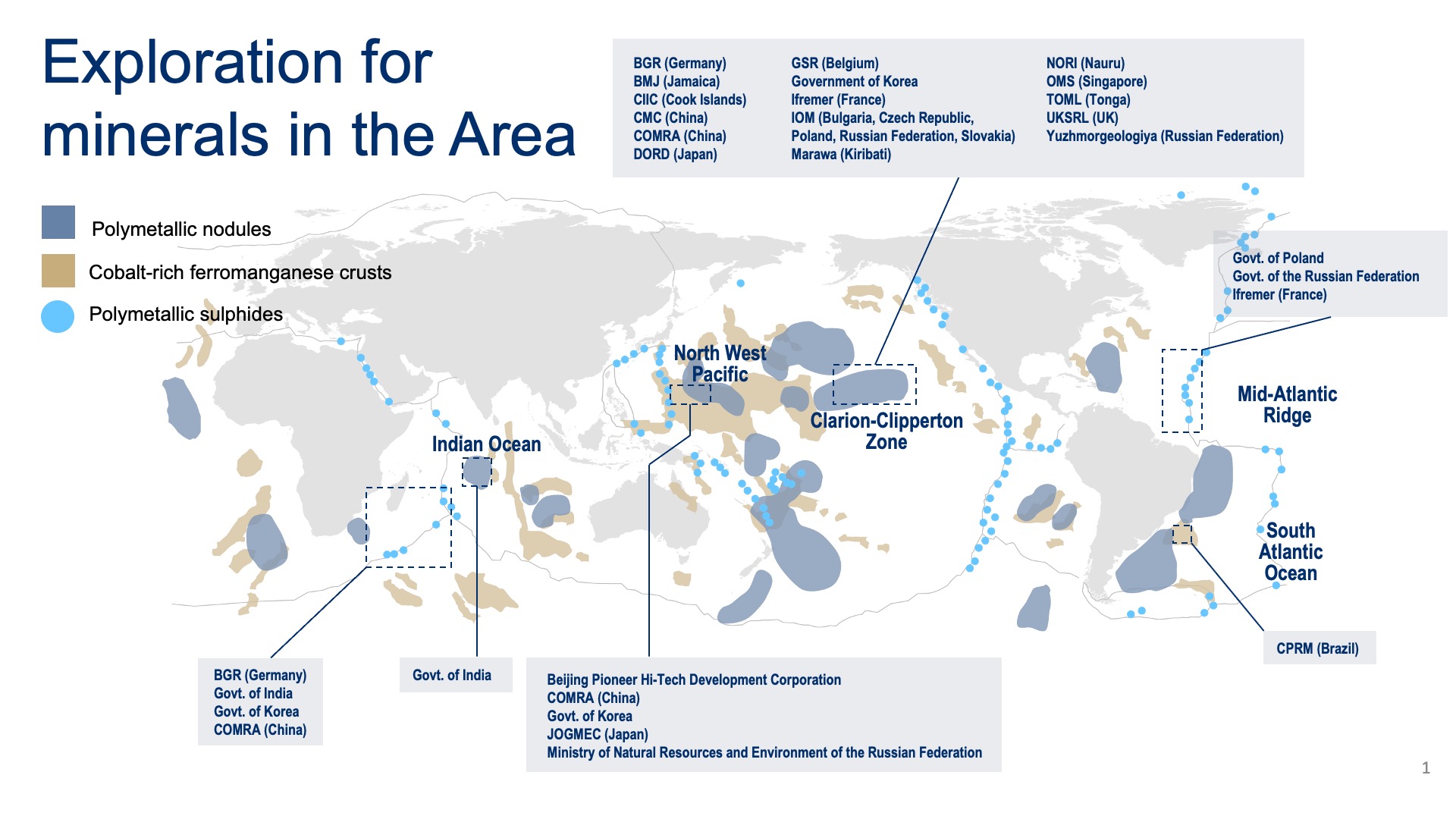
Location of deep sea minerals and countries with exploration licenses
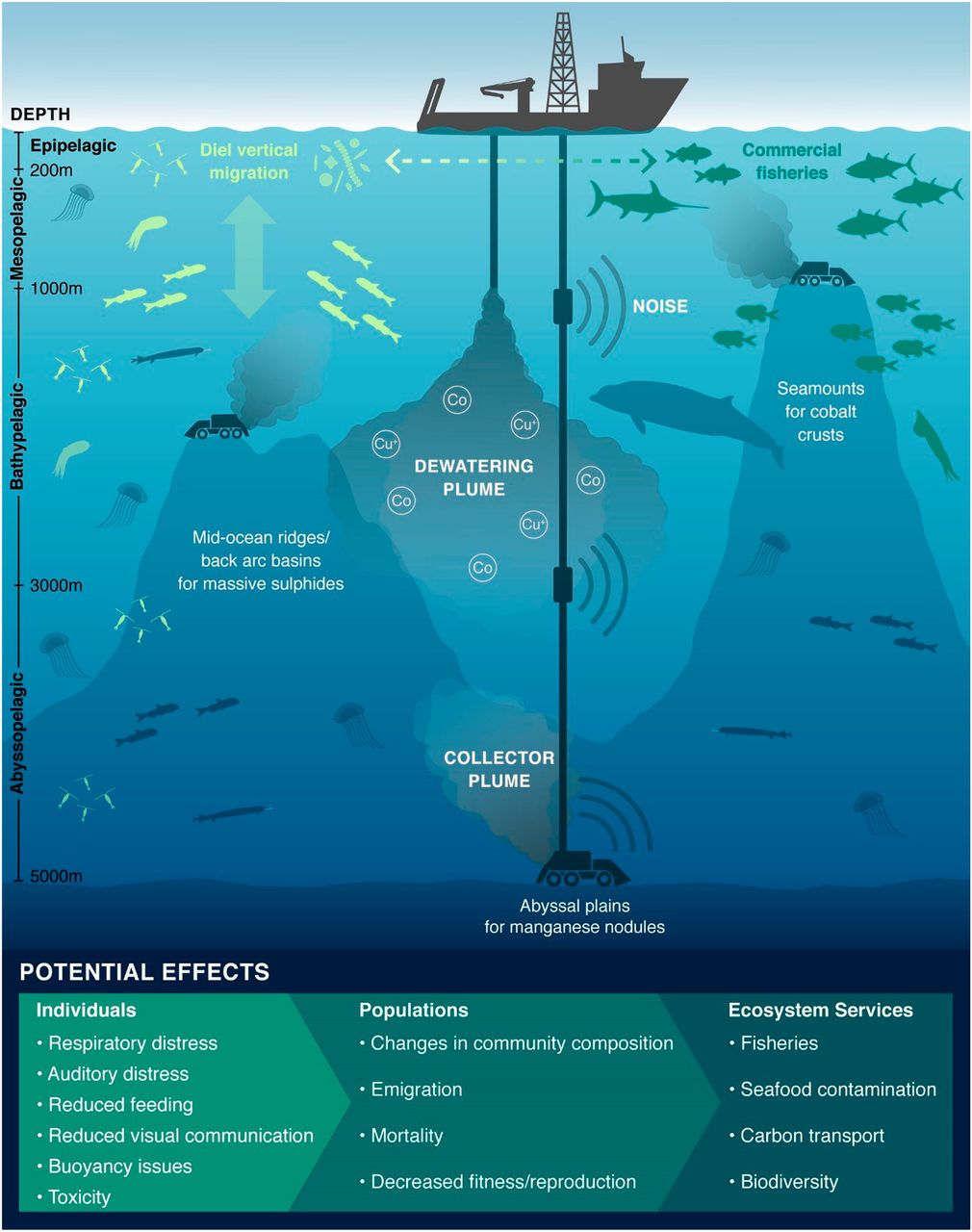
The effects of plumes and noise as a result of deep sea mining. A sediment plume in the deep sea potentially effects individual organisms, but also populations and ecosystem services.
Exploration and exploitation activities by huge machines are creating plumes of fine particles, which will travel across the seabed away from the mined area. In addition, the ore slurry transported to a ship at the sea surface needs to be dewatered and the waste water is returned to the sea, creating a discharge plume with a mixture of dissolved material and suspended particles of a range of sizes (see animation). A more turbulent environment delays the settling of particles on the seabed by stirring them higher into the water column. This spreads the impact of the plume over a wider area while also reducing its intensity. Modelling suggests that the plumes could cover an area several tens of thousands of square kilometres beyond mining sites, with sediment levels in the water far exceeding the amount that animals in the area have adapted to[4]Source: https://www.eu-midas.net/sites/default/files/downloads/MIDAS_research_highlights_low_res.pdf.
The deep sea is considered the least explored biome on Earth. Conditions within the deep sea are a combination of low temperatures, darkness, and high pressure. The extreme conditions make the environment difficult to access and explore and therefore very little is known about deep-sea ecosystems. The lowest ecological zone in a water body is called the benthic zone that also involves the sediments at the seafloor. Benthic biodiversity plays an important regulatory role in marine ecosystem functioning, including the transport of energy, solutes and materials within sediments and across the sediment–water interface.
Researchers have revealed an astonishing diversity of microscopic life thriving in the benthic zone[5]Source: https://www.sciencealert.com/dna-shed-by-deep-sea-organisms-reveals-an-abyss-teeming-with-life.They sampled the ocean floor at hundreds of points throughout the world and analysed the sediment collected at each spot for environmental DNA (eDNA). The researchers concluded that nearly two-third of the benthic diversity cannot be assigned to any known biological group.
Other researchers have demonstrated that polymetallic nodule fields are hotspots of abundance and diversity[6]Source: https://phys.org/news/2016-06-polymetallic-nodule-fields-hotspots-abundance.html.Much of the highly vulnerable fauna lives attached to nodules or in the sediment immediately beneath it. The majority of species are yet to be discovered but scientists think that as many as 10 million species may inhabit the deep sea. A recent study concluded that over 90% of the species observed within the Clarion Clipperton Zone, one of the first potential areas to be open to commercial deep-sea mining, are currently undescribed by science, highlighting just how little we know about deep-sea ecosystems[7] Source : https://doi.org/10.1016/j.cub.2023.04.052.
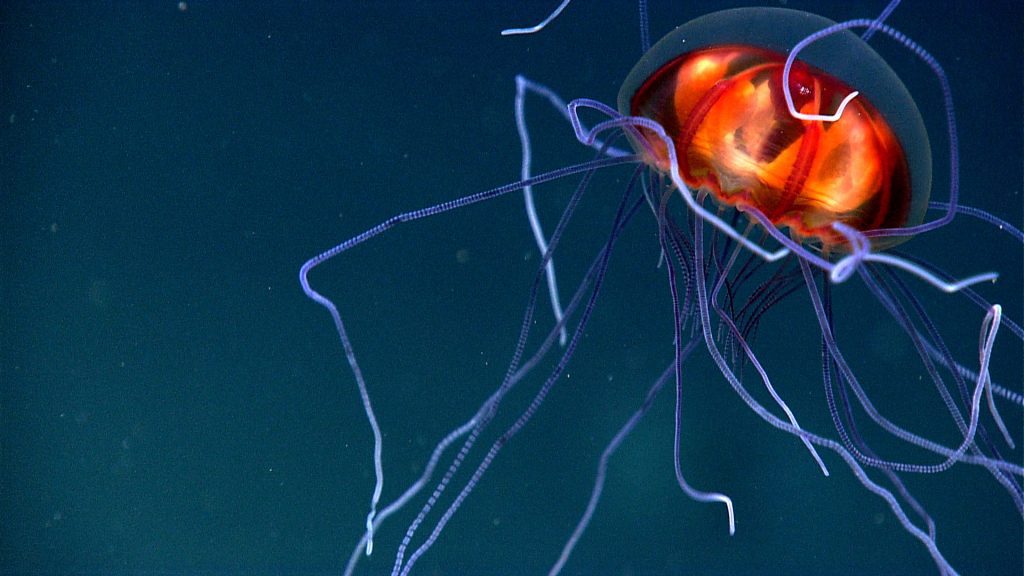
A hydromedusa, seen at just over 3900 m and just above the seafloor along the west wall of Mona Canyon. © NOAA OKEANOS EXPLORER Program, Oceano Profundo 2015; Exploring Puerto Rico’s Seamounts, Trenches, and Troughs
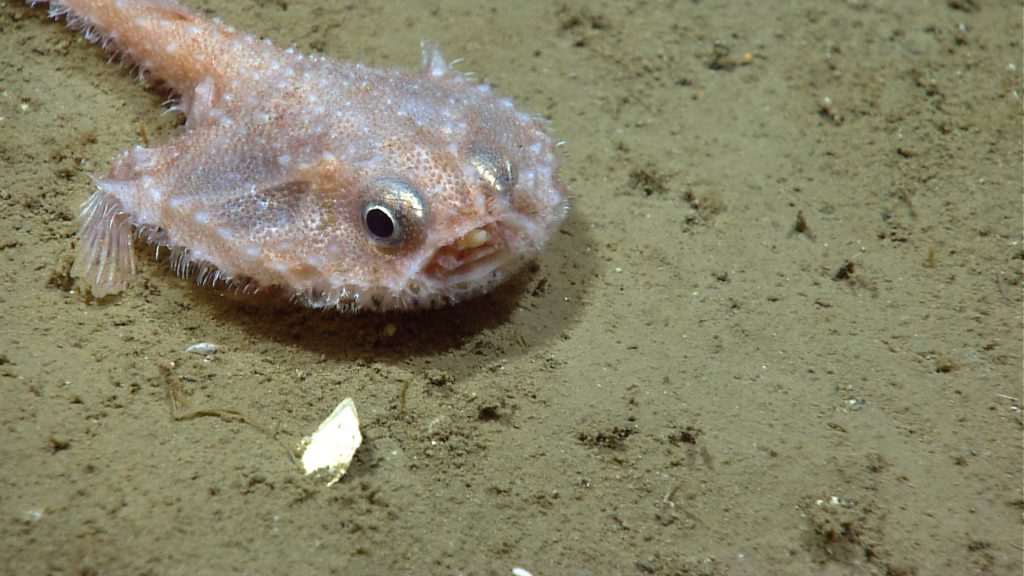
Batfish (Halieutichthys sp.). ©NOAA OKEANOS EXPLORER Program, Gulf of Mexico 2014 Expedition
Although more research is needed on the (long-term) impact of deep sea mining, scientists continue to warn there are serious concerns over the multiple impacts the activity would have. The most direct impact from deep-sea mining would be the loss of species and the fragmentation or loss of ecosystem structure and function. The noise of the machinery would affect wildlife, the scraping off of the seabed would kill animals and plants, and the sediment plumes smother and impact marine life of all zones of the ocean. The damage caused to the deep-sea ecosystems would most likely be permanent.
Deep-sea mining would also effect the higher ocean levels. Cumulative pressures from overfishing, climate change and pollution are putting the oceans and all marine life at risk of collapse. Deep-sea mining is a relatively new addition to the list of threats facing the oceans, but their effects could be catastrophic.
Scientists have divided the ocean into five main layers, known as “zones”. The surface layer of the ocean is known as the epipelagic zone and extends from the surface to 200 meters. It is also known as the sunlight zone because this is where most of the visible light exists. With the light comes heat. According to the UN Environmental Programme (UNEP), 60% of the world’s major marine ecosystems in the sunlight zone have been degraded or are being used unsustainably. Since the 1980’s an estimated 20% of global mangroves have been lost and 19% of coral reefs have disappeared. IUCN has assessed that nearly 10% (over 1,550 of the 17,903 marine animals and plants assessed) of global marine species are at risk of extinction.
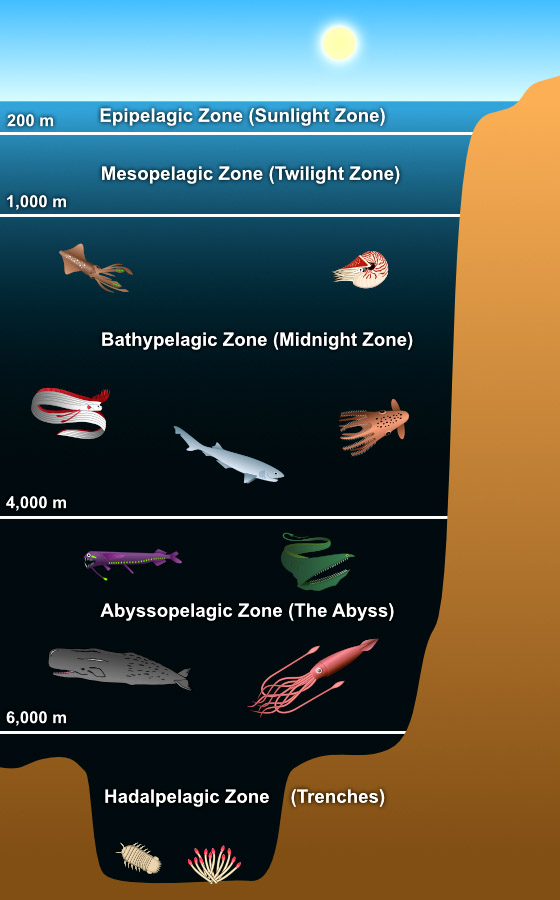
Deep sea zones
As we dive deeper into largely unexplored places, the temperature drops and the pressure increases at an astounding rate. At the most extreme depths where light can no longer penetrate, some of the most bizarre and fascinating creatures in the sea can be found. The ISA is working on a Mining Code deep-sea mining international waters. In 2024, the member states of the ISA Assembly will meet to discuss the impact deep-sea mining would have on the marine environment. Many experts hope this will lead to a ‘precautionary pause’ or moratorium. To date, 24 countries have called for a moratorium or pause on the industry. While the ISA is working on its code for the international waters, countries could already start mining projects in their own domestically controlled waters[8]Source: https://www.wri.org/insights/deep-sea-mining-explained.
Deep-sea mining could have a harmful impact on the climate. Not only is deep-sea mining an energy-intensive industry with high greenhouse gas emissions, but disruption of the ocean floor, which is by far the largest carbon storage reservoir on Earth, can lead to reduced carbon sequestration as well as the release of large amounts of the potent greenhouse gas methane, exacerbating the climate crisis[9] Source: https://phys.org/news/2024-01-disturbing-seabed-climate-worse.html.
An area of particular interest to companies in deep-sea mining is the Clarion-Clipperton Zone in the Pacific Ocean. So far, already 17 deep-sea mining contractors received exploration contracts for this zone, their combined exploration areas covering approximately 1 million square kilometres[10]Source: https://www.isa.org.jm/exploration-contracts/polymetallic-nodules/,
Pacific Peoples view themselves as custodians, not owners, of the ocean and its resources. This relationship links to traditional Indigenous understandings of the interconnected nature of the ocean, and how it serves as a network to reefs, and other shallow waters[11]Source: https://pacificpeoplespartnership.org/deep-sea-mining-in-tonga-nauru-and-kiribati/. Understandably, many members of civil society and traditional leaders have spoken out against deep-sea mining, largely out of concern for the health of their protected waters.
In Papua New Guinea, the Alliance of Solwara Warriors – comprising NGOs, Indigenous communities and religious groups across several island provinces – is demanding a permanent ban on deep-sea mining within PNG waters. The Alliance calls the deep-sea environment the “common heritage of mankind” and states that the world should “not even think about mining those areas.” They fear that the government is only focused on the return on investment they will get from deep-sea mining and are not concerned about people’s livelihoods. “We should be the guardian of the resources that creation has offered us. And not everything that we have is for monetary value.” The Alliance of Solwara Warriors argues that PNG has no need for seabed mining. “We are blessed with abundant fisheries, productive agricultural lands and marine life. Seabed mining would benefit only a small number of people who are already wealthy and not bring prosperity to our communities and Indigenous ways of life.”
Deep sea mining would not only result in the irreversible loss of species and damage the seabed for thousands of years, it would potentially result in negative consequences for the rest of the ocean, the climate, and the millions of people who depend on its health.
The world has a responsibility to care for the well-being of the marine ecosystems and of the people who rely upon and are connected to those spaces. We should protect the ocean environment from deep-sea mining and put people and places over profits.
At the IUCN World Conservation Congress in Marseille (September 2021), IUCN Members adopted Resolution 122 to protect deep-ocean ecosystems and biodiversity through a moratorium on deep-sea mining unless and until (amongst others) the risks of mining are comprehensively understood and effective protection can be ensured, and Policies incorporating circular economic principles to reuse and recycle minerals have been developed and implemented.
We urge the public- and business sectors in The Netherlands, the European Union and elsewhere to respect and extend the moratorium on deep-sea mining and prevent multiple impacts of seabed mining – the loss of species, the fragmentation or loss of ecosystem structure and function, and the loss of livelihoods for people who rely upon and are connected to those spaces.
There is no doubt that we need to accelerate the transition from fossil to renewable energy. However, the demand for certain raw materials is rising dramatically because of the energy transition. These raw materials are often extracted in areas with unique biodiversity, such as tropical forest, which leads to large-scale nature destruction. This is nature that we can’t do without: it provides millions of people with food and clean drinking water and helps us fight climate change. That is why, with the project Bottom Line!, a coalition of Dutch and international civil society organizations is working towards a fair energy transition with the least possible impact on people and nature. Both in the Netherlands and in the countries where the raw materials are extracted.
The Bottom Line! coalition consists of the following organizations: Alliance for Tompotika Conservation (AlTo) Indonesia, Alyansa Tigil Mina (ATM) Philippines, A Rocha Ghana, Deep Sea Conservation Coalition (DSCC), IUCN NL, Natuur & Milieu and Stop Ecocide NL. Bottom Line! is made possible with support from the National Postcode Lottery.


